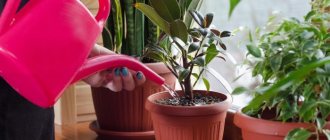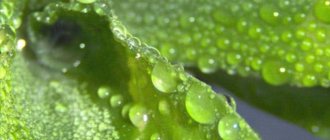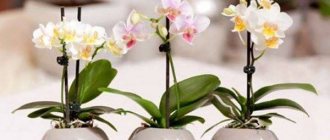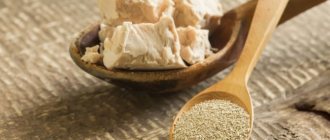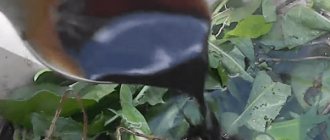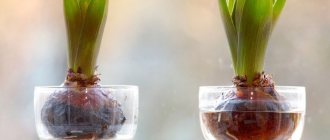Which plants are allowed and which are not?
Only a small number of indoor pets like to occasionally treat themselves to water with minerals dissolved in it.
These include cacti, which are accustomed to living and developing in desert conditions with a hot, arid climate.
To form strong needles and spines, shell rock, eggshells or chalk are added to the soil for cacti, so if the water is too soft, you can sometimes water the cactus with mineral water, this will be beneficial for its health.
A one-time watering with mineral water has a good effect on begonias , the leaves become shiny and the plant is abundantly covered with buds, but this can be done no more than once every two months.
There are flowers on the windowsills of amateur flower growers that cannot be watered with mineral water at all! Never and under no circumstances. These flowers include orchids.
In nature, these tropical plants are epiphytes, that is, they grow on other plants, but do not parasitize them, but receive moisture from the air and precipitation.
This video will tell you about watering indoor plants with mineral water:
Watering with mineral water
Is it possible to water indoor plants with mineral water? It is impossible to answer this question unequivocally in the affirmative. Some plants really benefit from mineral water in small quantities, while for others it is absolutely contraindicated. It all depends on the environment in which the flower grew in the wild.
In the tropics, flowers are more often found in a suspended state. Moreover, most of their nutrition comes from soft rainwater containing a small amount of dissolved mineral salts. In indoor conditions, such flowers require watering with settled, purified water without additional mineralization.
Flowers growing naturally in desert, dry soil are usually content with insufficient moisture. But it contains a huge amount of dissolved salts and minerals. They are accustomed to absorbing water with mineral impurities, so mineral water will not harm them.
The developer of CoviVac confirmed the possibility of revaccination with the drug
How to feed crocuses in March so that in April you will be pleasantly surprised by their flowering
We bake a whole basket of “mushrooms”: we take a plastic bottle to help
Main settings
It is logical to assume that the requirements for water used for watering indoor plants are much more serious. It should be soft and slightly acidic, contain oxygen, macro- and microelements. There is a concept of hardness, which in everyday life usually means the concentration of magnesium and calcium ions. Of course, it is better to water the plants with salt-free water. It is known that boiling slightly reduces the concentration of harmful substances. Therefore, the question arises as to whether it is possible to water flowers with boiled water.
Whey is very beneficial for plant growth. It saturates the root system with useful organic and mineral substances. If the roots receive good nutrition, then the above-ground part of the bushes will be healthy.
Irrigation with serum is an indispensable and effective prevention against fungal infectious diseases. The product works no worse than special fungicide preparations designed to combat pests and diseases.
Note! Do not water indoor plants with undiluted serum in its pure form. Otherwise, burns will appear on the leaf plates. The product is dissolved in water in a ratio of 3:1.
Tea is good for plants
Consequences
The big disadvantage of mineral water is that, in addition to microelements useful for plants, it contains a whole set of salts that settle both on the surface of the soil, which can be observed with the naked eye in the form of a white sediment, and in the depths of the earthen clod.
Salting the soil in a flower pot leads to negative consequences for the plant:
- Salts and alkalis in large quantities depress plants and can even lead to death.
- The soil becomes hard, which prevents oxygen from reaching the roots.
- Oversaturation with microelements does not allow the plant to develop correctly.
Mineral water cannot be used for regular watering of indoor plants; the harm caused by it will exceed the benefits many times over.
What is the best water to use for irrigation?
The best water for watering house plants is considered to be melt or rain water. But often getting it in the city is very problematic. And therefore, tap water is mainly used. In principle, it is not so bad, but sometimes it has a rather high chlorine content. And in large doses it leads to plant poisoning. The situation can be corrected by settling or filtration.
Also, not mineral water, but drinking water, which is often sold in 5-liter bottles, is very suitable for watering indoor plants. It is intended primarily for direct consumption or cooking and therefore contains very few mineral salts.
But it is even better, according to experts, to use water intended for use in office coolers. It is truly soft, since its purification is carried out by osmosis or ion exchange resins.
Author: Raudina Olga Valentinovna, botanist, master of forestry and forestry
Source
The possibility of watering indoor flowers with mineral water and its features
Good afternoon, my reader. For a long time, there has been a discussion among gardeners about which water is more suitable for watering houseplants: tap water, melt water, rain water, river water, or even water taken from an aquarium. But here the availability of water of one type or another should be taken into account. Somewhere there is no running water, somewhere there are no rivers, and precipitation is rare. But now you can buy mineral water almost everywhere. It was this that became the subject of controversy among home flora lovers about the benefits or, conversely, harm of using it for watering flowers.
Is it possible to water flowers with mineral water?
Mineral water, especially medicinal water, contains a lot of salts, which are not particularly necessary for a green pet. When watering with such water, you will simply “salt” the soil and slowly kill the plant.
You can water flowers with mineral water, but not with carbonated water, soda contains alkali, and this calcium is not absorbed by plants, so only without carbonated water, I water the flowers with ordinary water at room temperature and the flowers feel very good.
Even people should not drink too much mineral water and mineral water is not exactly minerals and food for plants.
Many have already experimented with such feeding and the conclusions are as follows:
In the best case, nothing will change and the plant will not grow (bloom) better.
In the worst case, the flower will first stop growing, then it will wither and, if the soil is not changed in time, it will die.
The most ideal water for watering indoor plants is rain or melted snow, but before watering it, it must be left for a day so that harmful substances settle to the bottom. Our ecology leaves much to be desired and there is practically no clean precipitation.
I somehow had mineral water left in a bottle and it was already without gas, it wasn’t tasty to drink, so I took it and poured it into the flowers. This flower later died; apparently the soil became too saturated with salts, which is not very desirable for some types of plants. It’s not without reason that fertilizer or vitamins are sold separately for almost every plant; each has something different, but there is also something universal.
How to prepare the solution
You can use any mineral water for irrigation, the main thing is that it is still. If you still have sparkling water, then you need to open the bottle and leave it like that for a day. Carbon dioxide will completely evaporate. Or pour into a glass or jar. In a day you will receive an excellent mineral supplement, which consists of magnesium, iron, selenium, calcium and many other necessary elements. Most importantly, all minerals are in an easily digestible form, which makes it easier for the roots to absorb the maximum amount of elements. However, it is not advisable to water plants with pure mineral water. High concentrations of minerals can damage the roots and simply burn your plant. Experienced gardeners prepare a solution from one liter of water and a glass of mineral water without gas.
Distilled water
It does not contain many microelements necessary for plants. Therefore, it can only be used when diluted by half with tap water. It is for this reason that it is taken quite rarely. But if the plant suffers greatly from hard water, then this option will be completely justified. Orchids, bromeliads, anthuriums, azaleas and other beautiful flowering plants especially do not like calcium and magnesium salts. But instead of distilled water, you can use boiled water; you will not lose anything.
Perfect option
Tap water is a poor choice. It contains impurities and salts of heavy metals. In addition, it contains a lot of volatile chlorine. To neutralize it, just pour water into a jar or bottle and let it sit for 24 hours. This procedure will not do anything with calcium, magnesium and iron salts, however, the liquid will become quite acceptable for violets. There is one secret that will allow you to grow these flowers lush and beautiful. Do not pour water under the roots or spray the plants. It is much better to take a pallet and line it with rounded pebbles. Now all that remains is to pour water into it - and the first part of the work is completed. You will need a fairly thick rope with a synthetic backing to prevent it from rotting too quickly. Pass it through the drainage hole and pull it through the entire thickness of the soil. Leave the tail peeking out. It will be saturated with liquid from the pan.
Some rules for watering flowers
If you don't know when to water your flowers, look at the surface of the soil. Dry soil indicates that the plant needs to be watered. Some plants grow well in dry soil. In this case, for watering, the soil must be dry not only on the surface, but also somewhat deeper.
Water your flowers early in the morning or evening. Water the plants more often in summer and less often in winter. Remember that each flower has an individual need for watering. For example, cyperus should grow in soil that is constantly waterlogged. Succulent plants, on the contrary, are practically not watered in winter.
Never water plants with cold water, only at room temperature. Otherwise, the plants will get sick, their roots will rot, their buds will fall off, and so on. Use a watering can with a narrow spout for watering. With the help of such a spout it is convenient to get to the very roots of the flower. When watering, the water stream should be directed downwards. The liquid should fill the entire distance between the edge of the pot and the soil level. After watering, water should seep into the pan. If this does not happen, repeat watering again. After 30 minutes, empty the water from the tray.
If you spray the plant, make sure it is not exposed to direct sunlight. Drops of water on the leaves are like small lenses. They will certainly cause a burn to the plant.
When to use
It must be said right away that such fertilizing is recommended to be used only in the spring and before the plants flower. If you decide to feed an already flowering plant, try not to get the solution on the delicate inflorescences. Of course, these are not artificial chemical compounds that can cause burns, but it is still better to protect the plant from stress. It is best to water flowers with mineral water once a month; no additional elements need to be added. The substances contained in the mineral water will be quite sufficient. By the way, there are no contraindications to the use of such feeding. It is suitable for both local and exotic flowers. Just be careful with the dosage and be sure to dilute the mineral water with plain water.
Found a violation? Report content
What kind of water is better to use?
Water for watering indoor flowers should be soft, that is, contain a small amount of salts, do not contain chlorine and carbon dioxide, and be moderately warm.
Three types of water are ideal for watering indoor pets:
- river;
- rain;
- melting from the snow.
For maximum benefit, you need to let it sit on the table for 24 hours and, if possible, acidify it, add a couple of handfuls of peat chips or a teaspoon of citric acid per ten liters.
Flowers do not like cold water; they need to be sprayed and watered with liquid warmed to room temperature .
All the most important and useful information about mineral water can be found in this section.
Is it possible to water flowers with tea leaves?
Tea is not water, water it
They can’t have plants every day.
Such feeding is carried out either once a week, or only when replanting the plant. To prevent mold or bugs from growing in the flower pot, the tea leaves can
be used dry.
... Tea can be
used warm or at room temperature.
Interesting materials:
Who invented the gasoline internal combustion engine? Who won the Battle of Borodino? Ankle boots what are they? Bremen Town Musicians Atamansha who sings? Caps lock what is it? Captcha what is it? Card reader what is it? What is the best way to wash oily hair? What is the best way to fill a hamster cage? What is the best way to clean rust?
What happens if you pour boiled and hot water on it?
In most Russian cities, the water flowing from the tap has increased hardness. As a result, after watering, plant roots suffer, and the surface of the soil becomes covered with a salt crust over time.
We recommend: Why do indoor plants feel cramped in a pot and how do you know when it’s time to replant them?
By watering plants with boiled water, you can get rid of the problem factor. It is first left to sit for 2-3 days to saturate it with oxygen. With this method of watering, the soil in pots must be loosened regularly so that air can reach the roots.
Professionals advise using hot water to water plants that do not bloom for a long time or refuse to grow. Actually, it should not even be watering, but a shower. The heating temperature is no more than 38° C, otherwise the flowers will “cook”. What's the trick here?
This procedure will become stressful for the plant and will bring it out of the state of unplanned sleep. At the same time, water jets will wash away pests, if any, from the flower. The shower cannot be used for specimens that have pubescent leaves (violets, begonias).


